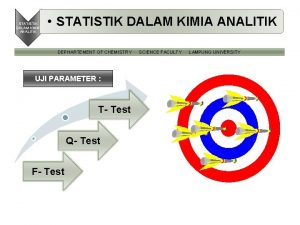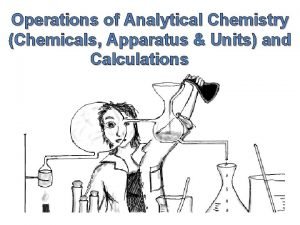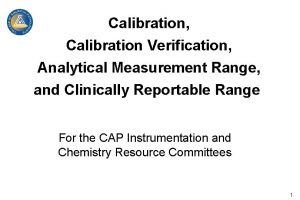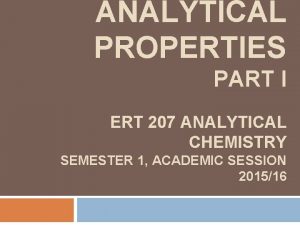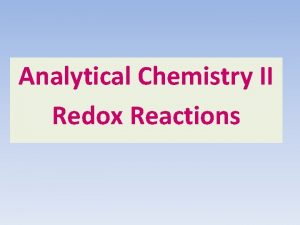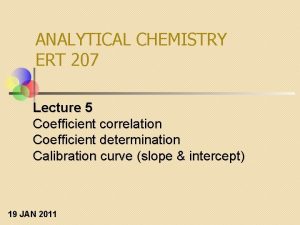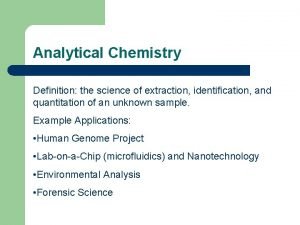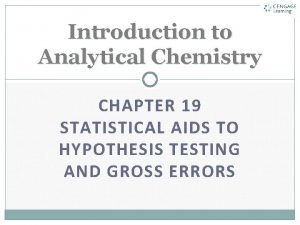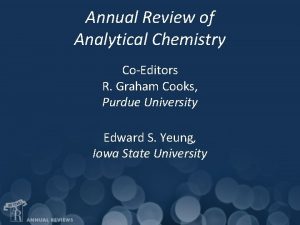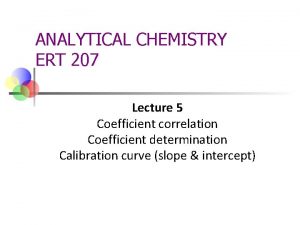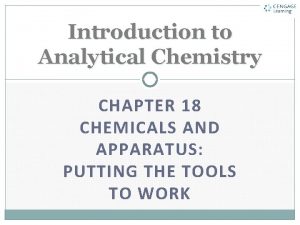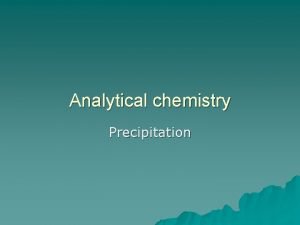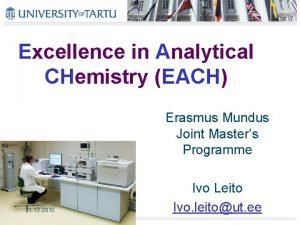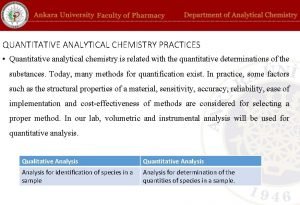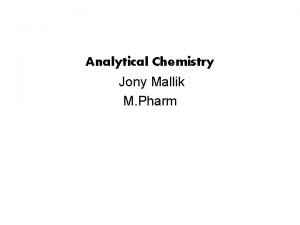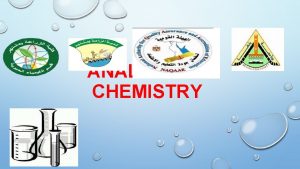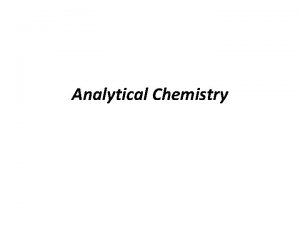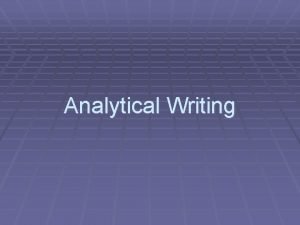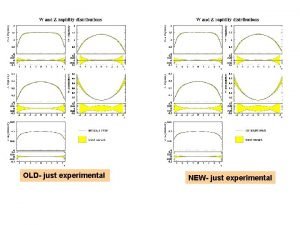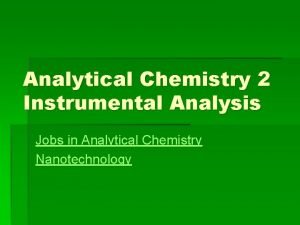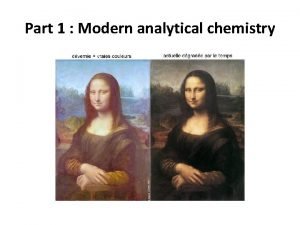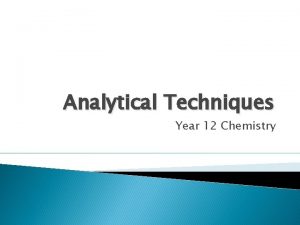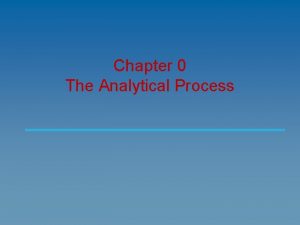Analytical Chemistry Division 2014 Analytical Chemistry Not JUST






















- Slides: 22

Analytical Chemistry Division 2014

Analytical Chemistry • Not JUST titrations! • We’re doing research in topics as diverse as better batteries, labs-on-chips, forensics, explosives detection and degradation, and better body armor. • We use almost every instrument you’ve seen plus some. • Two of the departments’ scanning probe instruments are in the Analytical Division.

Analytical Chemistry Members • • • CDR Rob Calhoun Professor Graham Cheek Professor Christine Copper Professor Judith Hartman Associate Professor Dianne Luning Prak Professor Dan O’Sullivan Professor Maria Schroeder Associate Professor Ron Siefert Professor Paul Trulove

RESEARCH INTERESTS Prof. G. Cheek Mi 144 36625 Solvents : Ionic liquids, water, acetonitrile Forensic Applications 1. Soil Characterization : X-Ray Fluorescence 2. Paper / Ink Characterization : Raman Spectroscopy

RESEARCH INTERESTS Prof. G. Cheek Effect of Lewis acids on organic reactions Use of NMR, UV-VIS ? + Yb(Tf. O)3 Ionic liquid BMPY Tf. O Bio-electrochemistry of amino acids also dipeptides ? - 2 e- 2 H+ cysteine cystine

Development of Separation and Detection Methods for Environmentally Important Molecules Prof Christine Copper ccopper@usna. edu Michelson 265 project will also include collaboration with scientists at the Naval Research Laboratory, Washington, D. C. or at Drexel University

Capillary Electrophoresis (CE) • • • CE was first used in the early 1980’s. Reasonably high sensitivity (ppm or ppb) Short separation time (<5 min) Small Sample Volume (nanoliters) Can be done on a microchip device instead of in a column *Separation is achieved based on different rates of migration of charged species in an applied electric field.

Instrumentation CE instrument is in MI 264. This automated instrument can run samples when you are not there!

Capillary Electrophoresis can be used to detect… • • Explosives in seawater Poisons in beverages Ozone in submarine atmospheres Nerve agents in atmospheres Polyaromatic hydrocarbons in environmental samples Carbon monoxide poisoning in blood Illicit drugs in urine Current students: Micala Migneault and Clay Aronica

Assoc. Prof. Dianne Luning Prak (prak@usna. edu) & Prof. Paul Trulove July 19 -20, 2012 demonstration successfully evaluated the performance of “drop in replacement” advanced biofuel [50 -50 mixtures of biofuel (made from used cooking oil and algae) and petroleum-based marine diesel or aviation fuel. ] http: //greenfleet. dodlive. mil/energy/great-green-fleet/ Midn 1/C Sarah Alexandre Fuel certification program/Office of Naval Research Goal: Analysis and testing of alternative fuels: density, viscosity, surface tension, speed of sound, bulk modulus, flash point, enthalpy of combustion (bomb calorimetry) Luning Prak, D. J. , Alexandre, S. M. , Cowart, J. S. , Trulove, P. C. , “Density, Viscosity, Speed of Sound, Alexandre, S. M. , Bulk Modulus, Surface Tension, and Flash Point of Binary Mixtures of N-Dodecane with 2, 2, 4, 6, 6 Pentamethylheptane or 2, 2, 4, 4, 6, 8, 8 -Heptamethylnonane” submitted to J. Chem. Eng. Data, 1/14

Photolysis of munitions constituents Unexploded Ordnance in shallow waters How does the photolysis behavior of munitions constituents in marine systems differ from that in fresh water systems? · salinity · nitrate · dissolved organic matter http: //www. SERDP. org Midn 1/C James Breuer SUNSHINE LAB Solar Simulator HPLC with autosampler Project involves · preparing solutions · using solar simulator · analyzing samples with HPLC · identifying products solid-phase extraction, LC/MS Luning Prak, D. J. , Milewski, E. A. , Jedlicka, E. E. , Kersey, A. J O’Sullivan, D. W. , 2013, “Influence of p. H, Temperature, Salinity, and Dissolved Organic Matter on the Photolysis of 2, 4 -dinitrotoluene and 2, 6 -dinitrotoluene in Seawater, ” Marine Chemistry, 157, 233 -241.

Professor Schroeder’s Research Interests Harold Edgerton, photographer Projectile hitting elastomer at > 500 mph - Improved Polymer Coatings for: - Military Transport (Humvees) - Body Armor - Hazardous Material Transport (DTRA) - Transparent Armor (ARL) - Laboratory Development: - Experiments in support of Chemistry of Cooking course - Experiments for the IL courses

Motivation for Coatings Research • To understand the mechanisms Ø Polymer synthesis, of impact protection of characterization, polymer-coated surfaces processing projectiles hitting Ø Engineering, physical and elastomers at high speed mechanical testing protection no protection Ø Materials Science • To understand temp effects (Tg) Ø Ballistic testing • To utilize nanoparticles Ø Basic research with military • To improve armor protection applications

Continuing Student Project (DTRA) Protective Coatings for Hazardous Material Transport Current Research Student 1/C Philip Solt North Dakota Dec 31, 2013 Train Derailment – Lac-Megantic, Quebec 74 train cars containing crude oil 42 persons killed, 30 buildings destroyed July 6, 2013 Research Collaboration: Naval Research Laboratory (NRL) Defense Threat Reduction Agency (DTRA)

Ron Siefert Associate Professor 3 -6336 (office), Mi-243 (office), Mi-240 (lab) Current Projects / Development of Nanoporous Sorbent Materials Novel Sorbents (PMOs: periodic mesoporous organisilicas) -For Analysis of Nitroenergetics (i. e, explosives) -For Analysis of Perchlorates (used as propellants) -As a substrate for catalysts to destroy contaminants Past Projects Vehicle NH 3 Emissions Agricultural NH 3 Emissions Measurements in the Chesapeake Bay Iron in Marine Aerosols Deposition of Nutrients to Surface Waters

Enhanced Detection of Explosives and Related Compounds Nanoporous Photocatalysts for Decontamination of Nerve Agents Lab on a Chip Microfluidic devices using electro-osmotic flow. OBJECTIVE: Develop organosilicas as sorbents applicable to the preconcentration of nitroenergetics and perchlorates for enhancement of in situ detection techniques APPROACH: Characterize the binding characteristics (e. g. , selectivity, capacity, kinetics) of imprinted PMOs for nitroenergetics and perchlorate propellants. Use of HPLC and IC.

Natural Fiber Welding - Ionic Liquid Facilitated Biopolymer Mobilization and Reorganization Prof. Paul C. Trulove, MI 248, trulove@usna. edu, 3 -6622 Natural materials with dramatically enhanced physical and chemical properties STATUS QUO Natural Polymers ·Natural polymers are renewable materials that have many attractive properties. Some natural silks have strength and toughness comparable to the best synthetic polymers. ·The ability to modify and tailor the shape and properties of natural polymers is limited. CH 3 COO− Ionic Liquids Solvents ·We have shown that ionic liquids are powerful solvents for the dissolution and processing of a wide variety of natural polymers. ·The solvating ability of ionic liquids provides a powerful tool for the modification and processing of natural polymers. Department of Chemistry MAIN ACHIEVEMENTS ·Investigated the impact co-solvent properties on the natural fiber welding process ·Demonstrated Inkjet printing of ionic liquids on natural fiber substrates ·Utilized Laser heating to spatially control the welding of natural fiber substrates ·Developed a continuous fiber welding process to coat yarns with functional solid materials ·Evaluated the electrochemical and knitting properties of yarn based supercapacitors ·Studied incorporation of fire retardant materials in natural yarns via fiber welding Research Goals Develop multi-functional natural materials and coatings with unique electronic, optical, and sensing properties for Air Force and Do. D relevant applications in areas such as ballistic protection, energy storage, microelectronics, stealth, laser eye protection, optical computing, chem. /bio sensing, in 17 situ medical applications END-OF-PHASE GOAL NEW INSIGHTS dramatically enhanced mechanical properties ·Enabling tuneable natural material properties with high spatial resolution ·Facilitating the integration of functional solid materials with electrical, magnetic and optical properties into natural fiber matrices QUANTITATIVE IMPACT Current Impact ·Producing natural materials with

Control of Natural Fiber Welding Using Inkjet Printing of Ionic Liquids piezoelectric inkjet thermal inkjet Movies Obtained from Wikipedia Department of Chemistry http: //en. wikipedia. org/wiki/Micro_Piezo Yellow – Rhodamine/Ionic Liquid Green – Substrate 18

Laser Induced Natural Fiber Welding Laser AFOSR Ionic Liquid Natural Fiber Substrate Use a Laser to Spatially Control the Welding of Ionic Liquid Coated Cotton Paper Ø CNC 40 W CO 2 laser with raster and/or vector operation Department ofby. Chemistry Full Spectrum Laser (www. fslaser. com) 19

Use of Ionic Liquids to Fabricate Biopolymer Composite Materials Knitted Electrochemical Capacitors for Smart Textiles* Bamboo (0. 54 mg/cm) Before Treatment After Treatment Department of Chemistry *Collaboration with Drexel University 20

Knitted Linen/Bamboo/Viscose Capacitors! + + + Yarn Electrode Yarn Separator VERY FLEXIBLE! Yarn Electrode separator Department of Chemistry 21

Questions?
 Too big too small just right
Too big too small just right Who was the first person to arrive at juliet's tomb
Who was the first person to arrive at juliet's tomb Vocabulary workshop level d unit 1
Vocabulary workshop level d unit 1 Short division vs long division
Short division vs long division What is synthetic division
What is synthetic division Repeated subtraction for division
Repeated subtraction for division Synthetic division method
Synthetic division method Analytical chemistry definition
Analytical chemistry definition Kesalahan dalam analisis data
Kesalahan dalam analisis data Pemeriaan
Pemeriaan Analytical chemistry apparatus
Analytical chemistry apparatus What is analytical measurement range
What is analytical measurement range Gaussian curve
Gaussian curve Analytical chemistry definition
Analytical chemistry definition Correlation coefficient in analytical chemistry
Correlation coefficient in analytical chemistry Definition of analytical chemistry
Definition of analytical chemistry Q test in analytical chemistry
Q test in analytical chemistry Annual review of analytical chemistry
Annual review of analytical chemistry Correlation coefficient in analytical chemistry
Correlation coefficient in analytical chemistry Analytical chemistry chapter 1
Analytical chemistry chapter 1 Special purpose reagent chemicals
Special purpose reagent chemicals Analytical chemistry
Analytical chemistry Excellence in analytical chemistry
Excellence in analytical chemistry









